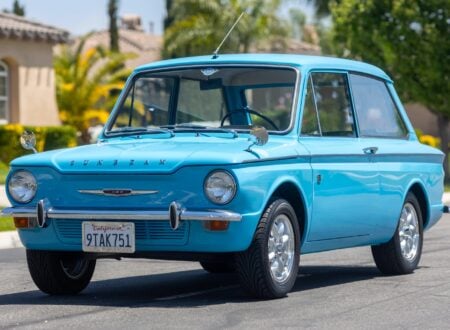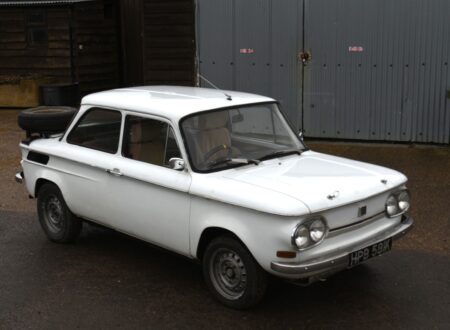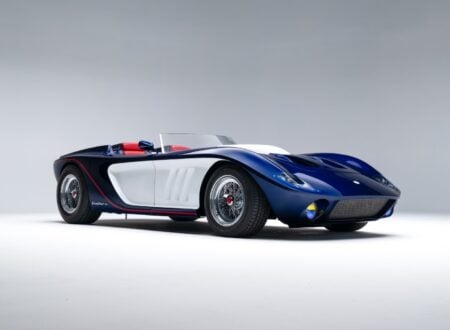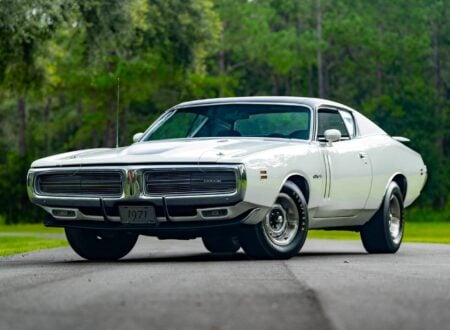This is a 1973 Ford Mustang SportsRoof that has been given the safari treatment, with a slew of upgrades to the suspension which allowed for the fitment of 31×10.50 Mickey Thompson Baja Legend MTZ tires on the 15″ Magnum 500-style wheels.
The car is now powered by a 351 cubic inch V8 which sends power back through a 3-speed automatic transmission to the rear wheels. The suspension was completely rebuilt for the safari conversion, and a roof rack and Hella driving lights have been added to complete the look.
Fast Facts: A Safari Mustang
- This 1973 Mustang SportsRoof was rebuilt as a safari-style car with a lifted suspension, 31×10.50 Mickey Thompson tires, and 15″ Magnum 500-style wheels. It runs a 351 V8 backed by a 3-speed automatic. Added gear includes a roof rack with Hella spotlights, as well as upgraded suspension, braking, and steering systems.
- The 1973 Mustang capped the first Mustang generation that had begun in 1964. The Mustang’s early market impact was phenomenal, the rapid development cycle kept it up at the pointy end of the market – thanks to the high-performance variants. After 1970 the model series shifted toward larger, heavier models as emissions, insurance costs, and fuel concerns reshaped the segment.
- The 1971-1973 cars grew in size, lost big-block options, and performance softened as regulations tightened. The 1973 model year is framed as a bookend, arriving just before the smaller, Pinto-based Mustang II. Changing economic and regulatory pressures altered what buyers expected from pony cars in the years that came after.
- The safari Mustang shown here keeps original bodywork but gains major suspension revisions, fresh steering components, refreshed power-assisted brakes, and a 351 V8 installed by a prior owner. Its cabin retains white vinyl upholstery, bucket seats, and a period stereo.
History Speedrun: The 1973 Ford Mustang
The 1973 Ford Mustang would be the end of the line for the first generation Mustang series which had started back in 1964 and completely revolutionized the American sports and GT car world – starting a whole new market that was named after it – the “Pony Car.”
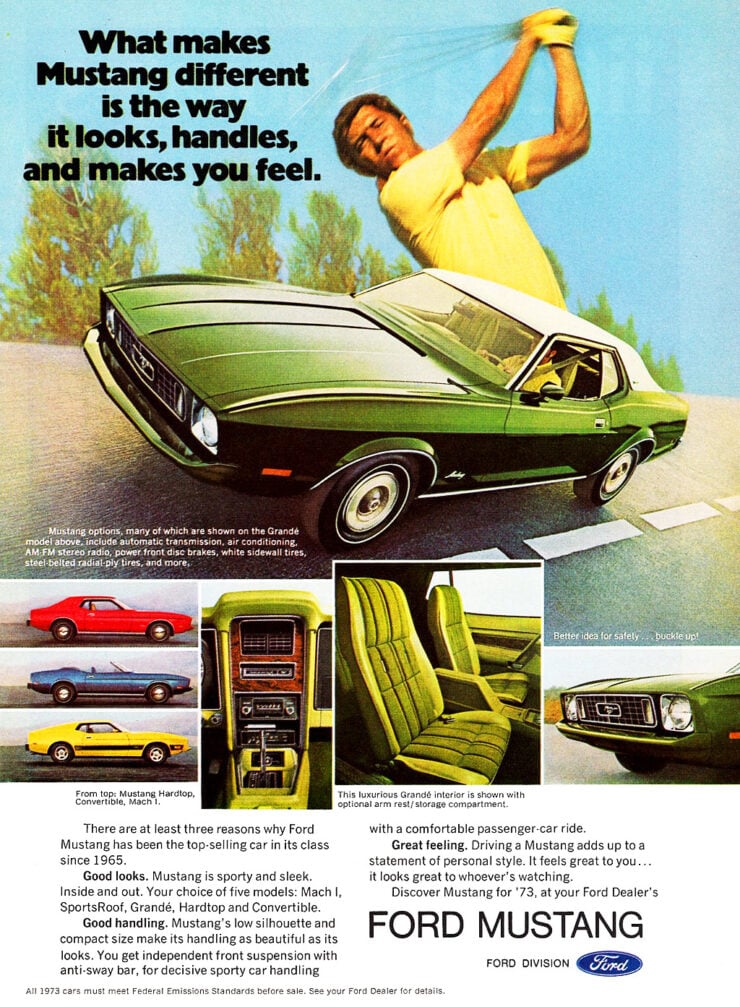

The first-generation Ford Mustang had landed in April of 1964 with the kind of cultural impact most automakers can only dream about. Ford’s product planners had sensed a shift in the early sixties with younger buyers wanting something more stylish than a compact sedan but more affordable than a Thunderbird.
The answer was a long-hood, short-deck coupe based on Ford Falcon underpinnings, built to hit a low price point while still allowing buyers to pick from a long list of engines and other options. It worked instantly.
Ford sold more than a million Mustangs in the first eighteen months, vastly more than they anticipated in even their wildest estimates, and as a result the industry would soon see Chevrolet, Pontiac, AMC, Plymouth, and Dodge building their own Mustang rivals.
The earliest Mustangs, typically referred to as the 1964½ cars, were simple, crisp, and lightly tailored. Buyers chose from the 170 cubic inch six, the 260 cubic inch V8, or the now-famous 289 cubic inch V8, and the whole package weighed far less than the big-block muscle cars that would soon dominate the upper end of the V8 market.
The Mustang wasn’t initially built to outgun anything on a drag strip, it was meant to look good, feel modern, and let owners option their car to their own personality. That mix proved hard to resist, and by 1965 and into 1966 the Mustang was everywhere, from high school parking lots, Hollywood films, SCCA circuits, executive parking lots, and Ford showrooms from coast to coast.
Updates throughout the production run of the first-gen Mustang came quickly, largely because the market moved quickly around it. The 1967 to 1968 cars grew slightly to clear room in the engine bay for the 390 and later the 428 Cobra Jet, a sign of the rising horsepower competition across Detroit.
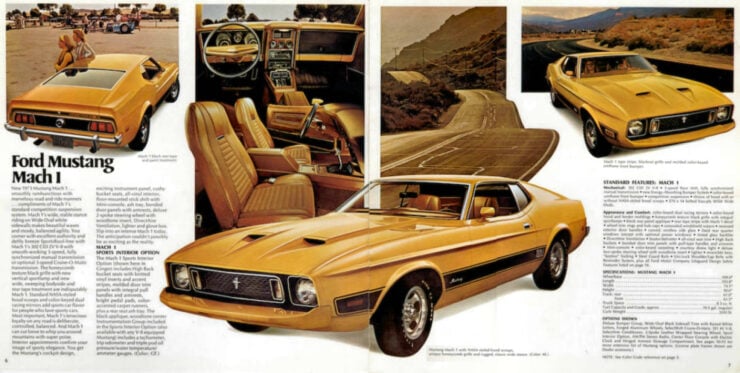

The 1969 restyle gave the car a more aggressive look with an “angrier” front end and sharper sheetmetal, while branching out into variants like the Mach 1, Boss 302, and Boss 429. Those models helped to further advance the Mustang’s real sporting (and motorsport) credentials, tying the program more closely to Trans-Am racing and Ford’s broader performance push.
By 1971, however, the landscape was changing. Insurance costs were rising, fuel economy mattered more, and federal emissions and safety rules were tightening each year. Ford responded with a larger Mustang, it was longer, wider, and heavier, designed to still carry big-block engines but with more luxury features.
It was still recognizably a Mustang, but the svelte feel of the mid-sixties was gone – that shift mirrored the entire pony car market, which was beginning to struggle under new regulatory and economic pressures.
The final year of the first generation came in 1973. Styling carried over from the 1971 to 1972 models with only small trim changes, but under the skin the Mustang was clearly running out of road. Big-block engines were now gone as options, compression ratios were down, and performance numbers tumbled as Ford worked to meet increasingly strict emissions standards.
The 302 remained the only V8 option, delivering usable torque but nothing like the punch of earlier years. Even the suspension and braking packages now leaned more toward comfort than speed – signaling an industry-wide change in how Ford expected buyers to use the car.
Despite the headwinds, the 1973 Mustang sold reasonably well and remains an interesting snapshot of its era. It closed out the original Mustang generation, just before Ford pivoted to a radically different idea for 1974.


The Mustang II would be lighter, smaller, and more fuel-focused, based on the smaller Pinto platform shaped by the energy crisis and market trends that simply didn’t exist when the first generation arrived. That’s what makes the 1973 model year such a clear bookend. It’s the last of the early Mustangs built before external pressures permanently reshaped the entire American performance car landscape.
The Safari Ford Mustang Shown Here
The 1973 Ford Mustang you see here has been given a comprehensive safari conversion, it keeps the styling of the original car but now rides on far larger tires, and it has a series of significant suspension modifications to make it all possible.
The car received some work under a previous owner, adding a 351 cubic inch V8 with a lot more punch than the 302 that came with the car originally. It was also given a Mach 1 decal package at this time, though it’s not an original Mach 1 car.
The current owner, and now seller, is the one who really transformed the way the car looks, and what it’s capable of. The suspension was completely overhauled and lifted with replacement shock absorbers, new shock mounts and stabilizer bar links, replaced control arms, ball joints, rear leaf springs, perches, and U-bolts.
As a result of all this, the car now rides much higher, and there’s enough room under those unmodified wheel arches for the set of 31×10.50 Mickey Thompson Baja Legend MTZ tires it now has, these are fitted to period-correct 15″ Legendary Wheel Company Magnum 500-style wheels.
When the suspension was being upgraded the power-assisted brakes were also serviced with the installation of a replacement master cylinder, booster, wheel cylinders, shoes, and drums. The car also has power steering, replacement tie rods, pitman, and idler arms.
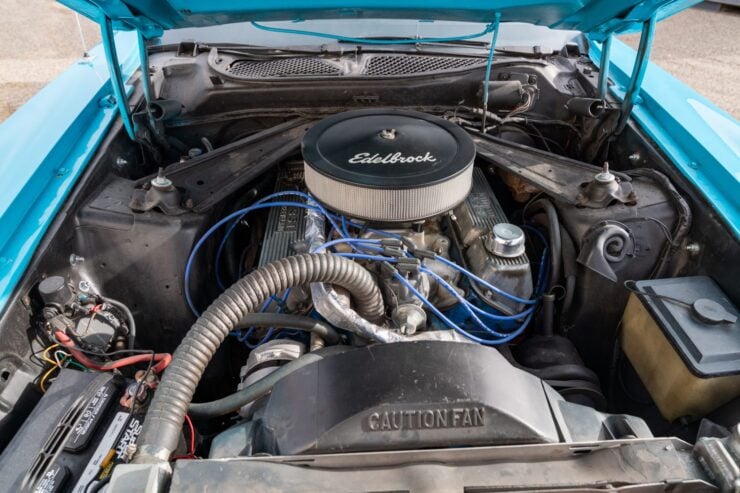

Inside you’ll find twin bucket seats up front with a bench in the back, all trimmed in matching white vinyl. The car has an AM/FM/cassette stereo, a floor-mounted center console, a clock, and front shoulder belts.
The car is now being offered for sale out of Bozeman, Montana and you can visit the listing hereyou can visit the listing here if you’d like to read more about it or place a bid.

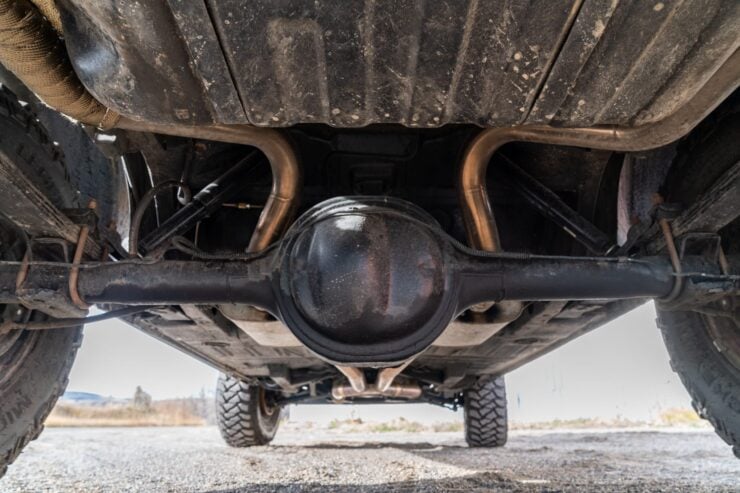


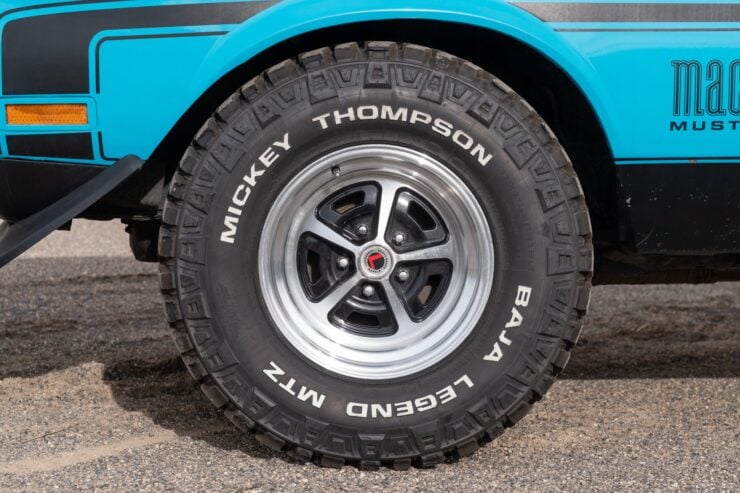

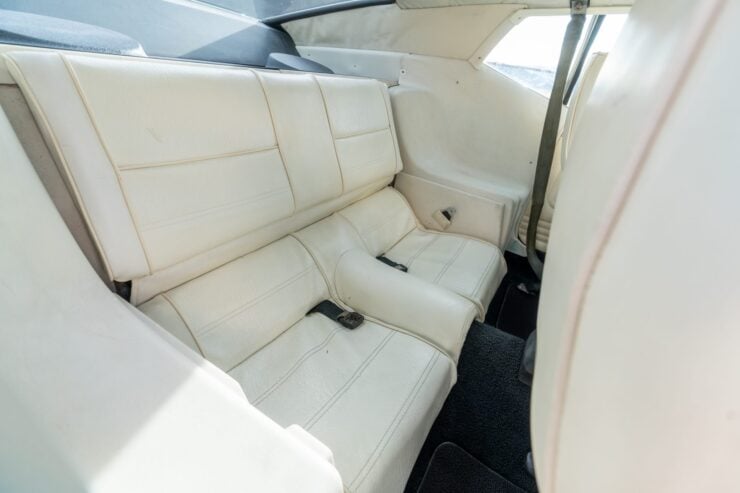



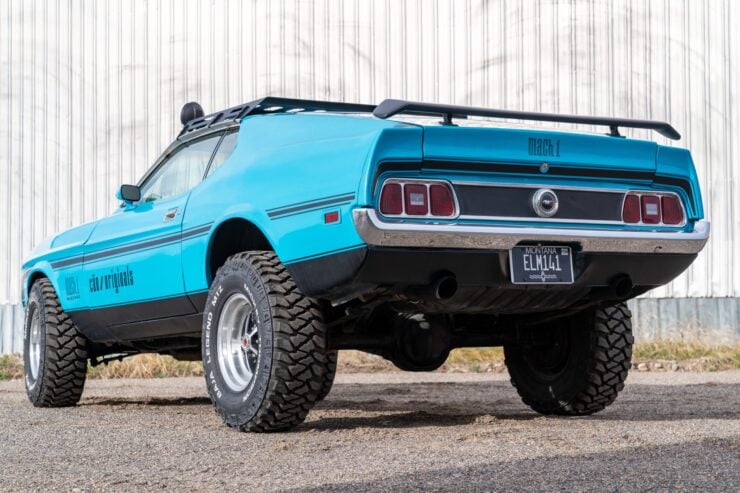

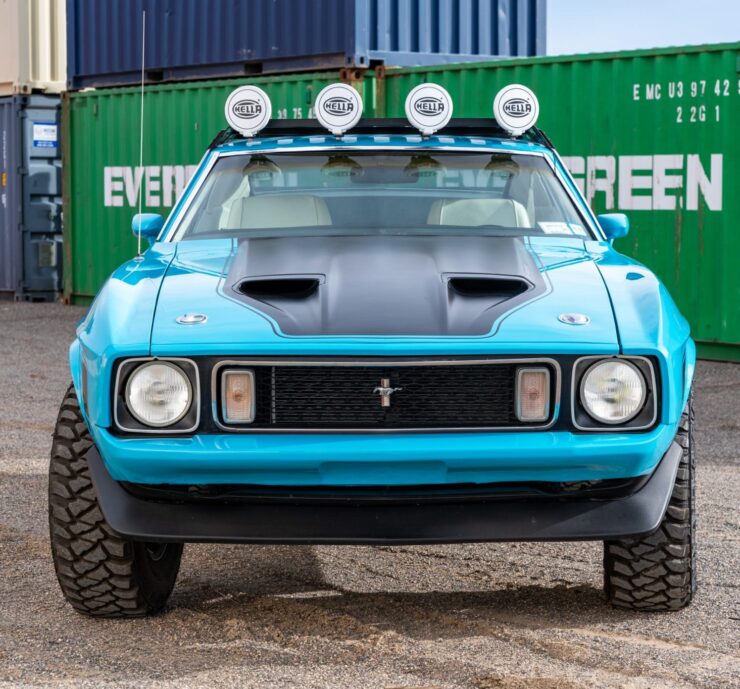


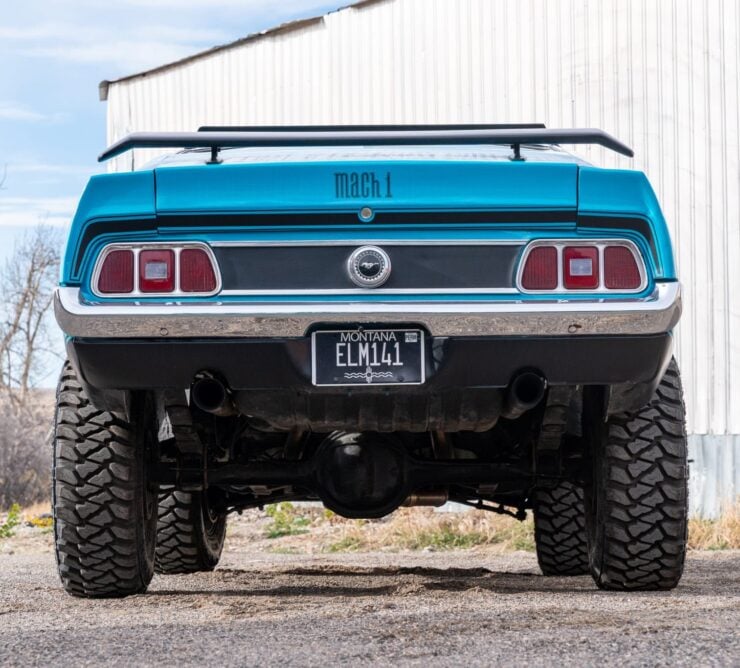
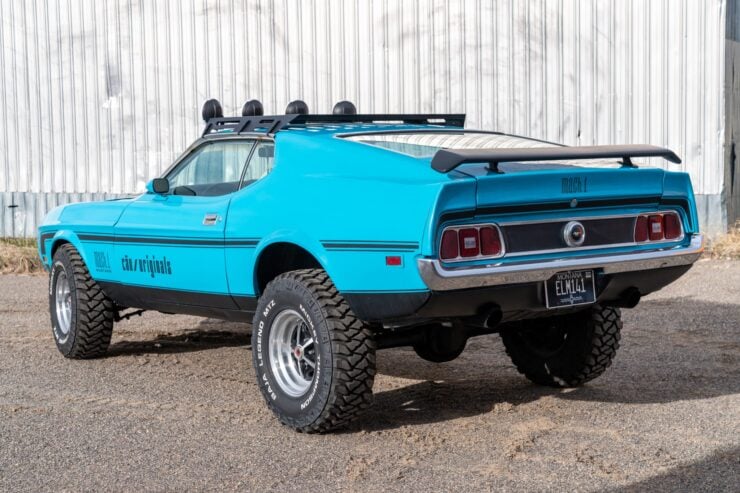

Images courtesy of Bring a Trailer



